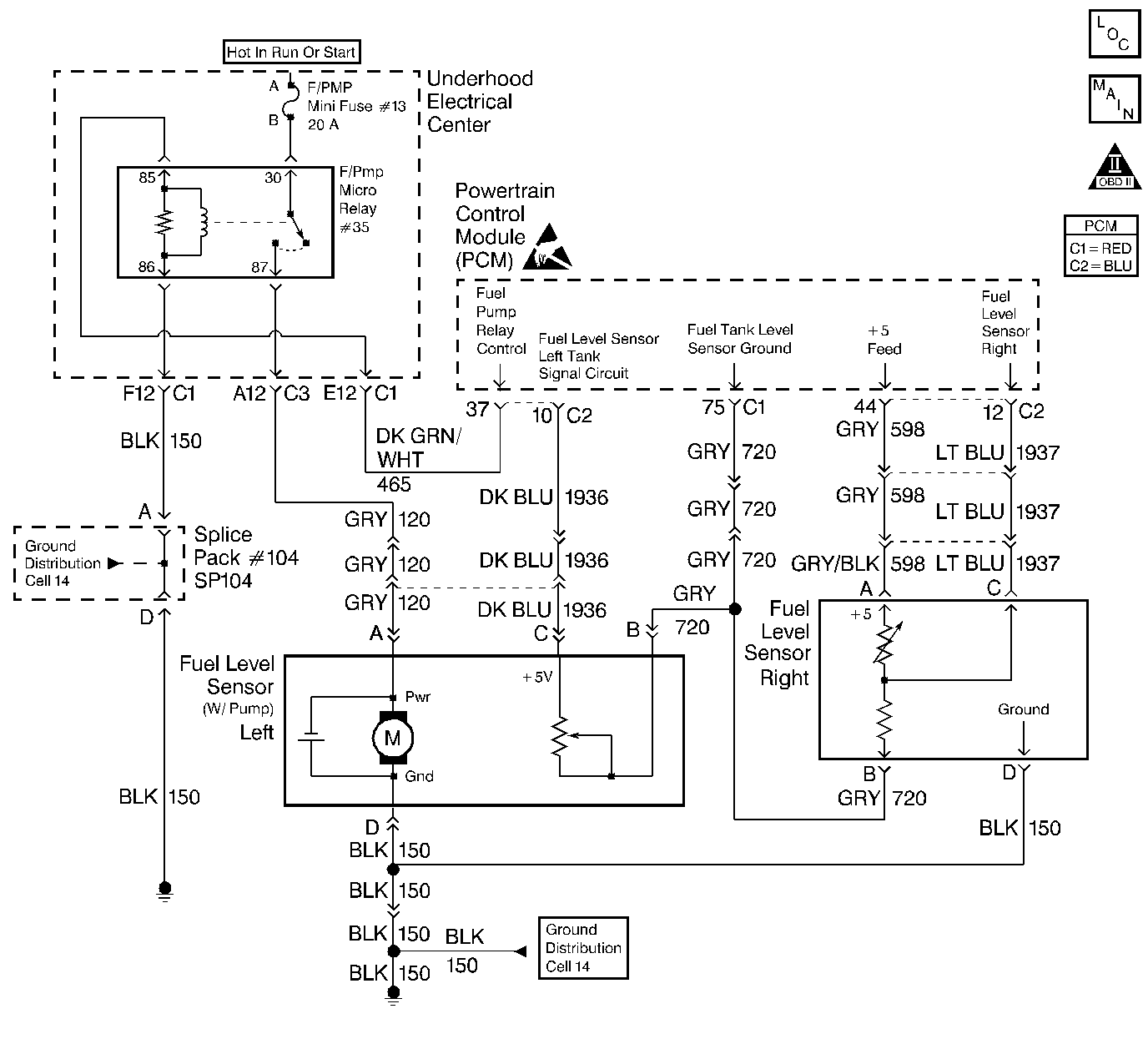
Circuit Description
The Fuel Level sensor 2, mounted in the rear side of the right fuel tank, measures fuel level changes within the right fuel tank. The Fuel Level sensor 2 has a 5.0 volt reference circuit, a ground, and a signal circuit.
When the fuel level is low the sensor output voltage is high. When the fuel level is high the sensor output voltage is low.
The PCM uses inputs from the Fuel Level sensor 1 and the Fuel Level sensor 2 in order to calculate the total fuel remaining in both fuel tanks. The system sends this information via the serial data to the BCM. This information displays on the fuel gauge.
When the PCM senses a signal voltage higher than the normal operating range of the sensor, this DTC sets.
Conditions for Setting the DTC
| • | The Fuel Level sensor 2 voltage above 2.9 volts. |
| • | The above condition present for greater than 50 seconds. |
Action Taken When the DTC Sets
| • | The powertrain control module (PCM) stores the DTC information into memory when the diagnostic runs and fails. |
| • | The malfunction indicator lamp (MIL) will not illuminate. |
| • | The PCM records the operating conditions at the time the diagnostic fails. The PCM stores this information in the Failure Records. |
Conditions for Clearing the DTC
| • | A last test failed, or current DTC, clears when the diagnostic runs and does not fail. |
| • | A history DTC will clear after 40 consecutive warm-up cycles, if no failures are reported by this or any other non-emission related diagnostic. |
| • | Use a scan tool in order to clear the DTC. |
Diagnostic Aids
The following occurs with this DTC set:
| • | The vehicle fuel gauge displays empty. |
| • | The Check Gauge lamp illuminates. |
| • | The Driver Information Center displays a message. |
Using the Freeze Frame and/or Failure Records data may aid in locating an intermittent condition. If you cannot duplicate the DTC, the information included in the Freeze Frame and/or Failure Records data can help determine how many miles since the DTC set. The Fail Counter and Pass Counter can also help determine how many ignition cycles the diagnostic reported a pass and/or a fail. Operate vehicle within the same freeze frame conditions (RPM, load, vehicle speed, temperature etc.) that you observed. This will isolate when the DTC failed. For an intermittent condition, refer to Symptoms .
Test Description
The numbers below refer to the step numbers on the diagnostic table.
Step | Action | Value(s) | Yes | No |
|---|---|---|---|---|
1 | Did you perform the Powertrain On-Board Diagnostic (OBD) System Check? | -- | ||
2 |
Did DTC P1635 Fail This Ignition cycle? | -- | ||
Is the fuel level sensor right tank voltage above the specified value? | 2.9V | |||
4 |
Does the scan tool indicate that this diagnostic failed this ignition? | -- | Refer to Diagnostic Aids | |
5 |
Is the Fuel Level Sensor Right Tank voltage below the specified value? | 1.0V | ||
6 | Probe the fuel level sensor right tank ground circuit with a test lamp J 35616-200 to B+. Does the test lamp illuminate? | -- | ||
7 |
Was the fuel level sensor right tank sensor signal circuit shorted? | -- | ||
8 | Measure the voltage at the fuel level sensor right tank 5.0 volt reference circuit to ground using a DVM J 39200 . Is the voltage greater than the specified value? | 5.1V | ||
9 |
Did the terminal require replacement? | -- | ||
10 |
Did the terminal require replacement? | -- | ||
11 |
Was a condition found and corrected? | -- | ||
12 |
Did you find and correct the condition? | -- | ||
13 |
Important:: Program the replacement PCM. Refer to Powertrain Control Module/Throttle Actuator Control Module Replacement . Replace the PCM. Is the action complete? | -- | -- | |
14 | Replace the fuel level sensor right tank. Refer to Fuel Sender Assembly Replacement . Is action complete? | -- | -- | |
15 | Repair the 5.0 volt reference circuit for a short to voltage. Is the action complete? | -- | -- | |
16 |
Does the scan tool indicate that this test ran and passed? | -- | ||
17 | Select the Capture Info option and the Review Info option using the scan tool. Are any DTCs displayed that have not been diagnosed? | -- | Go to the applicable DTC table | System OK |
